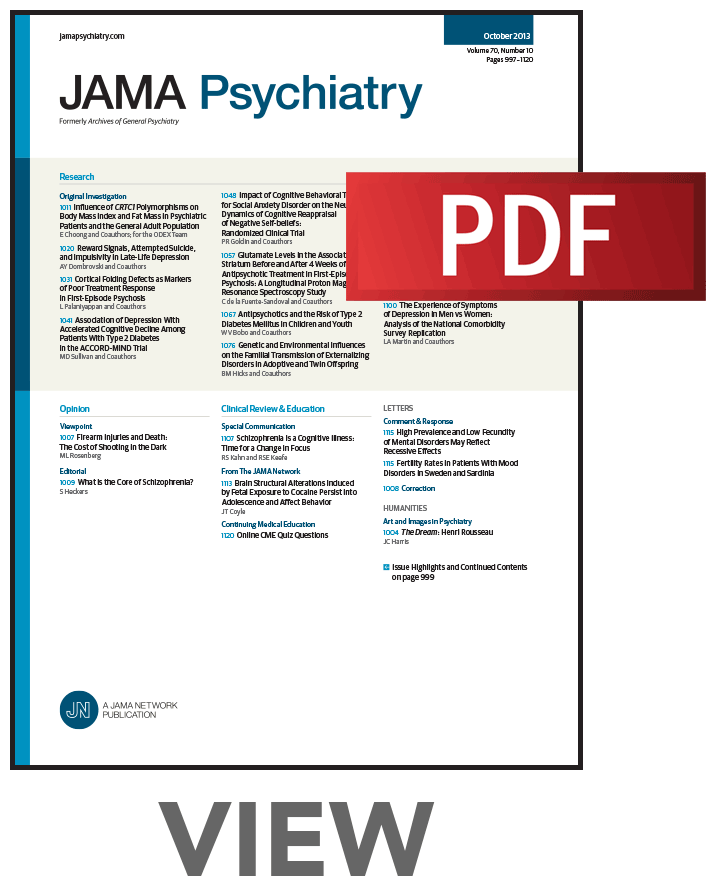在物质使用障碍恢复期间吸烟。
IF 17.1
1区 医学
Q1 PSYCHIATRY
引用次数: 0
摘要
重要性吸烟在有其他物质使用障碍(sud)的人群中比没有其他物质使用障碍的人群更为普遍。然而,在SUD治疗机构中,戒烟干预措施经常缺失。目的通过评估吸烟状况和SUD随时间的恢复情况,了解戒烟和SUD护理的相关信息,以确定从当前吸烟过渡到以前吸烟是否与SUD的持续恢复有关。设计、环境和参与者本队列研究是在PATH(烟草与健康人口评估)研究中具有全国代表性的有SUD病史的美国成年人队列中进行的。PATH研究是美国一项正在进行的、具有全国代表性的纵向队列研究。分析包括第1波队列(2013/2014年招募)的成年人(年龄≥18岁),每年评估4年,直到第4波(2016/2018年)。第二个具有全国代表性的队列(2016/2018至2023年)也进行了敏感性分析评估。数据分析于2024年6月至2024年9月完成。暴露吸烟(从不吸烟、以前吸烟和现在吸烟)。主要结局和测量主要结局是SUD恢复,通过个体需求全球评估-短筛选SUD子量表进行评估,测量为高终生SUD症状(4-7个症状)和过去一年的零症状(持续缓解)或高终生SUD症状合并任何过去一年的症状(当前药物使用或SUD)。固定效应logistic回归评估了吸烟的人内变化及其与SUD恢复的关系,并考虑了人之间的混杂因素。结果2013/2014年至2016/2018年的2652名成年人中,41.9% (95% CI, 39.4%-44.4%)为女性,平均年龄为39.4岁(95% CI, 38.7-40.3)。根据自我报告的种族和民族,17.0%的参与者(95% CI, 15.3%-18.9%)为西班牙裔,13.9% (95% CI, 12.2%-15.6%)为非西班牙裔黑人,63.1% (95% CI, 60.4%-65.7%)为非西班牙裔白人,6.0% (95% CI, 4.9%-7.4%)为其他非西班牙裔种族(亚洲人、美洲原住民/阿拉斯加原住民、夏威夷原住民/其他太平洋岛民,超过一个种族)。从现在吸烟到以前吸烟的个人内部变化与SUD的恢复呈正相关:每年改变以前吸烟的人与恢复的几率增加30%相关(优势比[OR], 1.30;95% CI, 1.07-1.57),考虑时变协变量和人与人之间的差异。在预测滞后1年后,这种关联仍然显著(OR, 1.43;95% CI, 1.00-2.05),在2016/2018年至2022/2023年评估的第二队列中(OR, 1.37;95% ci, 1.13-1.66)。结论和相关性在这项队列研究中,从当前吸烟到曾经吸烟的个人内部变化与其他sud的恢复有关。这些结果表明,戒烟可以作为一种工具来帮助康复过程和改善成人SUD的健康状况。本文章由计算机程序翻译,如有差异,请以英文原文为准。
Cigarette Smoking During Recovery From Substance Use Disorders.
Importance
Cigarette smoking is more prevalent among those with than without other substance use disorders (SUDs). However, smoking cessation interventions are often absent from SUD treatment facilities.
Objectives
To inform smoking cessation and SUD care by assessing smoking status and SUD recovery over time to determine whether transitioning from current to former smoking is associated with sustained SUD recovery.
Design, Setting, and Participants
This cohort study was conducted among a nationally representative cohort of US adults with history of SUD from the PATH (Population Assessment of Tobacco and Health) Study. The PATH Study is an ongoing, nationally representative, longitudinal cohort study in the US. Analyses included adults (aged ≥18 years) in the wave 1 cohort (recruited in 2013/2014) assessed annually over 4 years until wave 4 (2016/2018). A second nationally representative cohort (from 2016/2018 to 2023) was also assessed in sensitivity analyses. Data analysis was completed from June 2024 to September 2024.
Exposure
Cigarette smoking (never, former, and current use).
Main Outcomes and Measures
The primary outcome was SUD recovery, assessed via the Global Appraisal of Individual Needs-Short Screener SUD subscale, measured as high lifetime SUD symptoms (4-7 symptoms) and zero past-year symptoms (sustained remission) or high lifetime SUD symptoms with any past-year symptoms (current substance use or SUD). Fixed-effects logistic regression assessed within-person change in smoking and its association with SUD recovery, accounting for between-person confounders.
Results
Among 2652 adults from 2013/2014 to 2016/2018, 41.9% of participants (95% CI, 39.4%-44.4%) were female, and mean age was 39.4 years (95% CI, 38.7-40.3). By self-reported race and ethnicity, 17.0% of participants (95% CI, 15.3%-18.9%) were Hispanic, 13.9% (95% CI, 12.2%-15.6%) were non-Hispanic Black, 63.1% (95% CI, 60.4%-65.7%) were non-Hispanic White, and 6.0% (95% CI, 4.9%-7.4%) were another non-Hispanic race (Asian, Native American/Alaska Native, Native Hawaiian/Other Pacific Islander, more than 1 race). Within-person change from current to former smoking was positively associated with SUD recovery: year-to-year change to former cigarette use was associated with a 30% increase in odds of recovery (odds ratio [OR], 1.30; 95% CI, 1.07-1.57), accounting for time-varying covariates and between-person differences. This association remained significant after lagging predictor by 1 year (OR, 1.43; 95% CI, 1.00-2.05) and in the second cohort assessed from 2016/2018 to 2022/2023 (OR, 1.37; 95% CI, 1.13-1.66).
Conclusions and Relevance
In this cohort study, within-person change from current to former smoking was associated with recovery from other SUDs. These results suggest that smoking cessation could be used as a tool to assist recovery processes and improve health among adults with an SUD.
求助全文
通过发布文献求助,成功后即可免费获取论文全文。
去求助
来源期刊

JAMA Psychiatry
PSYCHIATRY-
CiteScore
30.60
自引率
1.90%
发文量
233
期刊介绍:
JAMA Psychiatry is a global, peer-reviewed journal catering to clinicians, scholars, and research scientists in psychiatry, mental health, behavioral science, and related fields. The Archives of Neurology & Psychiatry originated in 1919, splitting into two journals in 1959: Archives of Neurology and Archives of General Psychiatry. In 2013, these evolved into JAMA Neurology and JAMA Psychiatry, respectively. JAMA Psychiatry is affiliated with the JAMA Network, a group of peer-reviewed medical and specialty publications.
 求助内容:
求助内容: 应助结果提醒方式:
应助结果提醒方式:


